2010 Annual Science Report
 University of Hawaii, Manoa
Reporting | SEP 2009 – AUG 2010
University of Hawaii, Manoa
Reporting | SEP 2009 – AUG 2010
Solar System Icy Body Thermal Modeling and Evolutionary Pathways
Project Summary
Thermal evolution models have been developed and applied to various classes of small, icy
solar system bodies in order to understand the longevity and composition of volatiles materials
they contain, and to explore the evolution of these bodies. The models use a quasi-3D
thermal evolution code, which is combined with astronomical observations, and dust-
dynamical modeling. We have completed a parameter study of ice in the new class of objects
called the main belt comets, and have found that unexpectedly, water ice can survive over
the age of the solar system under certain conditions. This provides exciting prospects for
potentially exploring a previously unexplored reservoir of early solar system volatiles. We are
extending these models to comets which spend less time in the inner solar system and have
found that for comet Kopff, there is a volatile other than water driving some of the activity. This
modeling is being extended to Centaur objects which are evolving dynamically into the inner solar system from the Kuiper belt region.
Project Progress
Survival of ice in Main Belt Comets – a parameter study
The discovery of the new class of objects, known as Main Belt Comets (MBCs), raises a number of questions. These objects exhibit dual characteristics: physically, they appear and behave like active comets, while dynamically they resemble asteroids, residing in the main asteroid belt in stable orbits of relatively low eccentricity. The prevailing concept that comets and asteroids are distinct classes of objects, the former ice-rich and the latter ice-poor, is thus severely challenged. The cometary behavior of MBCs is best illustrated by the earliest discovered such object, 133P/Elst-Pizzaro, which showed similar coma and tail evolution at three consecutive perihelion passages. This implies a thermally driven process, such as activity from water ice sublimation. MBCs most likely formed in-situ, in the outer asteroid belt, although some may have more recently been transported from the outer belt to their current orbits. Previously, any location in the belt had been considered too hot for ice survivability for 4.5 Gyr. The low conductivity of porous cometary material suggests, however, that ice may be retained in the interior of main belt bodies, despite continual insolation. The purpose of this study is to investigate the conditions for survival of water ice, by means of detailed numerical modeling of long-term evolution. The questions that we address are: To what extent and under what conditions may water ice be preserved in MBCs for long durations and how deep below the surface is the ice expected to be found?
We find that large bodies (up to a few km in diameter) may retain ice over the age of the solar system even at shallow depths of the order of 50 m. Smaller bodies in the inner belt, on the other hand, might lose their ices. Members of Collisional families, which may be much younger (as is likely for the currently observed objects), are more likely to have ice at depths as shallow as 10-20 m, accessible to activation by collisions. We have submitted a paper for publication on this project.
Attached are examples of figures from the paper (end of report) with shows the relative depth where water ice can survive as a function of closest approach to the sun (perihelion) and at what distance and size the body complete dehydrates.
Internally-Driven Dust Activity in Comet 22P/Kopff – Thermal and dust-dynamical modeling
Comet 22P/Kopff was one of the targets of the CRAF (Comet Rendezvous Asteroid Flyby) mission, which was canceled by NASA in 1992. As such, it has been observed extensively on different occasions. It was discovered in and experienced about eight close approaches to the giant planets, the most dominant of them with Jupiter. These perturbations affected mostly its inclination and perihelion distance. Its current orbit lies between those of Mars and Jupiter, with a small ecliptic inclination of ~4 degrees and an orbital period of ~6.4 yr. It has a significant coma activity, even before perihelion, and a dust trail, distinguishable as an extended feature in both optical and IR measurements.
Optical CCD observations were obtained during several extensive observing campaigns between 1989-2010, using the UH 2.2-m telescope on Mauna Kea. These were used to make deep composite images to search for dust. Dust-dynamical models were developed for the available observations datasets, using the Finson-Probstein method (F-P). This method models a cometary tail in order to determine onset and cessation of emission, dust particle production rates, sizes, and velocities. These parameters are used as boundary conditions for the thermal models. Thermal evolution models of the nucleus of 22P/Kopff were calculated, by means of a quasi-3D thermal evolution code. For these specific models we have focused on the location of the directed emission, as derived from the dust-dynamical modeling. We examine the dependence of the activity on a few key parameters by following the outgassing of volatiles, ejection of dust and heat transport inside the nucleus. We have found that the models suggest that there was directed activity from the southern hemisphere of the comet, many months after this region of the nucleus would have been out of direct sunlight, suggesting that the source of activity comes from volatiles at depth (e.g. CO or CO2). This is one of the first in-depth test of utilizing coupled thermal and dust modeling and will be developed as a powerful tool in a thesis project. A paper is in preparation on this project.
The accompanying figure shows the composite image of the comet, from the 1992 observation, and contour plots of the image and the corresponding best-fit dust model. A second figure shows the dust production rates, for several variation of the nucleus model. Each variant model is represented by the two orbits that had the most similar dust activity behavior to the one derived from the F-P analysis.
Dynamical and thermal pathways in the evolution of Centaur objects
The structural and thermal evolution of small Solar system bodies may be strongly dependent on their dynamical history and environment. Objects on planet-crossing orbits are prone to gravitational perturbations that de-stabilize their orbits. Such are the Centaurs, which are the transient population, between the relatively stable trans-Neptunian objects (TNOs) and the short-lived Jupiter family Comets (JFCs). This may indicate that these objects experience intermediate levels of internal processing, at different periods of their lives. Examining the evolution of several these Centaur objects, both in orbital and physical parameters, can help categorize the different states and origin and evolution scenarios in the outer Solar system.
Determining the dynamical evolution of each object is achieved through statistical analysis of the results of multiple N-body integrations. This is achieved by using many clones of specific objects, with known orbital elements. Statistics of large clone samples of specific objects yield valuable information about their current states and future fates. Specifically, and with greater importance to thermal evolution, we focus on the dynamical lifetimes, survivability and mean orbital elements. Profiles of temperature, structure and composition are calculated utilizing our robust thermal evolution code several specific objects, which represent slightly varying dynamical groups, and for different orbits of the same object, which represent specific orbital evolution pathways.
In this study we aim to investigate the scenarios for the origin and evolution of a Centaur object, in terms of its orbital and thermo-physical evolution. The following are the components of this project: (i) Follow the long-term dynamical evolution of several representative samples of unstable orbits in the trans-Neptunian space, in order to identify the source population of Centaurs, formulate a time-dependent injection rate of objects into the giant planet region and constrain the size-distribution of Centaurs; (ii) Study the stability regions in the Centaur orbital space (outer Solar System), by means of statistical analysis of many clones of observed Centaur objects; (iii) Study the interior thermal evolution of various objects, as dependent on their dynamical stability, perihelion distance, size and composition, and its relation to observed surface properties.
Project progress – Modeling efforts for the 3 components of the projects are on their way. Thermal modeling has been completed for ~5 Centaur objects. Dynamical modeling of the observed Centaur population has been completed and preliminary statistical analysis has been done. Dynamical modeling of the trans-Neptunian source population, in collaboration with Dr. Lykawka from Japan’s Kinki University, has been initiated recently.
Attached are 3 figures, representing the different components of the project showing the initial populations for the long-term integrations, the composition and cumulative distribution functions for the lifetimes of the Centaurs
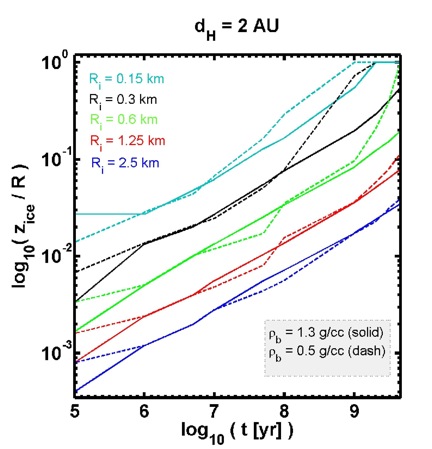
The figure shows the relative depth where water ice can survive during the evolution of various-sized objects (colored curves), representing the conjectured MBC population. Low and high-density cases are plotted, for each object (dashed and solid curves), and the axes are set in logarithmic scale. This is for orbits with a perihelion distance of 2 AU (inner boundary of the main asteroid belt).
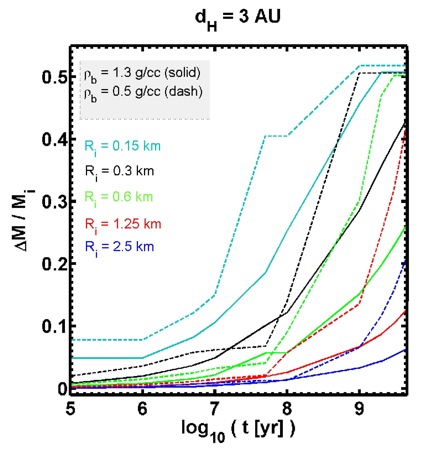
The figure shows the relative depth where water ice can survive during the evolution of various-sized objects (colored curves), representing the conjectured MBC population. Low and high-density cases are plotted, for each object (dashed and solid curves), and the axes are set in logarithmic scale. This is for orbits with a perihelion distance of 3 AU (outer boundary of the main asteroid belt) and shows the time evolution of the mass loss, due to sublimation of water ice from the bulk of the nucleus. Since dust and ice are taken in equal proportions (by mass), the maximal mass loss is 0.5, corresponding to complete “dehydration” of the nucleus.
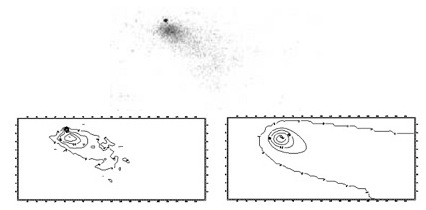
Top: Median combined composite image of comet 22P/Kopff, from 1/6/92. Note that the tail is disconnected from the nucleus. Bottom-left: Contour plot for the median combined composite image of comet Kopff. Bottom-right: Contour plot of the best-fit model for the 1/6/92 image. For all, north is at the top and east to the left. Images are 395,000 by 190,000 km in the plane of the sky.

Dust production rates of the two most similar orbits, for all thermal models tested for comet 22P/Kopff. The production rate is normalized to the maximum rate of the orbit, in order to examine the qualitative behavior of the dust emission. Time is presented in days relative to perihelion and only the near-perihelion parts of the orbits are shown. We compare in each panel the results of the dust-dynamical modeling (black +), the earlier orbit (blue crosses) and the later orbits (green +).

This figure shows the initial populations chosen for the long-term orbital integrations of Centaurs, compared to the known distributions of outer Solar System objects (taken from the Minor Planet Center database). The middle panel shows the rates of injection of objects from the trans-Neptunian space into the Centaur orbital space, as number of Centaurs derived from each source population (color coding of injection rates corresponds to the color of the initial source population in the top panel). The bottom panel compares the orbital element distribution (semi-major axis and eccentricity) of the simulation-derived Centaurs (in red) to that of observed objects (in black, taken from the Minor Planet Center database).
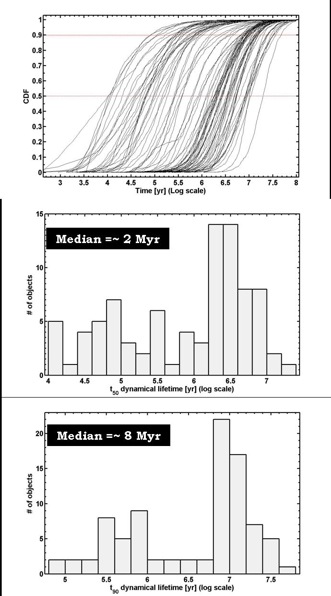
The top of the figure shows a composition the cumulative distribution functions (CDFs) of lifetimes for the individual Centaurs. Each curve is a CDF of 1000 orbital integrations of clones for each real Centaur, with each clone varying by 1/100,000 part of its orbital elements from the known orbit. The red dotted lines represent the 50% (median) and 90% levels of the CDF, where 500 and 900 clones, respectively, have already been removed from the simulation. Middle and bottom panels of the figure show the histogram of the 50% and 90% dynamical lifetimes, with resulting median lifetimes for the intrinsic known Centaur population of 2 and 8 Myr, respectively.
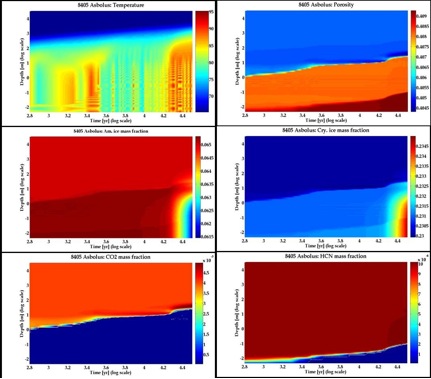
Evolution of internal profiles for a Centaur with the orbital and known physical characteristics of 8405 Asbolus. The profiles are of the temperature, porosity, amorphous water ice mass fraction, crystalline water ice mass fraction, CO2 ice mass fraction and HCN mass fraction, and are set on a logarithmic scale for depth (y-axis, in meters, where the surface is at the lower end of the axis0 and time (x-axis, in years, where initial time recorded is ~600 years).
-
PROJECT INVESTIGATORS:
-
PROJECT MEMBERS:
Gal Sarid
Project Investigator
Karen Meech
Co-Investigator
Dina Prialnik
Co-Investigator
Anthony Zenn
Graduate Student
-
RELATED OBJECTIVES:
Objective 1.1
Formation and evolution of habitable planets.
Objective 2.2
Outer Solar System exploration
Objective 3.1
Sources of prebiotic materials and catalysts